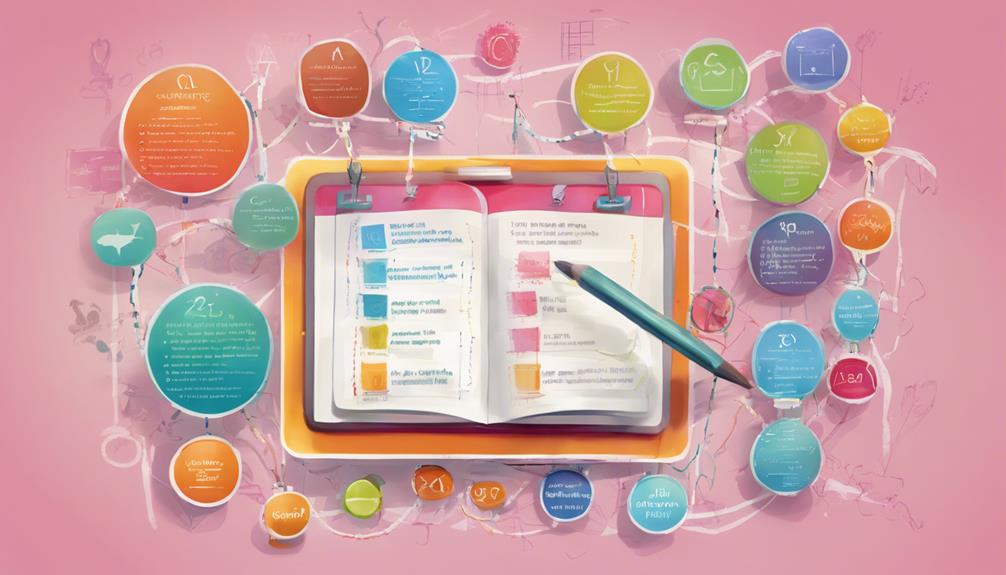Personal Goal Tracking
The Ultimate Checklist for Effective Goal Tracking!
Jumpstart your goal-tracking success with this comprehensive checklist – learn how to set, prioritize, and achieve your goals effectively!
Enhance your goal-tracking effectiveness! Define your purpose clearly, set SMART goals, prioritize based on importance, create action plans, and track progress diligently. Empower yourself through growth, seek accountability and support, celebrate achievements, and reflect on adjustments. By following this ultimate checklist, you'll boost your chances for success and personal development.
Key Takeaways
- Set SMART goals to ensure specificity, measurability, achievability, relevance, and timeliness.
- Prioritize goals based on significance, urgency, and personal values to stay focused.
- Create an action plan with manageable steps, tracking methods, and deadlines for accountability.
- Monitor progress by tracking milestones, assessing indicators, and adjusting action steps.
- Reflect on progress regularly, celebrate achievements, and make necessary adjustments for continuous growth.
Purpose Definition

To effectively track your goals, start by clearly defining your purpose. Your purpose is like a compass guiding you towards meaningful accomplishments. By understanding your purpose, you lay a solid foundation for setting goals that truly resonate with your values and aspirations.
Purpose definition is essential because it keeps you motivated and focused, even when challenges arise.
When you have a clear purpose, tracking your goals becomes more effective. Your purpose serves as a constant reminder of why you started on this journey in the first place, helping you stay on course and persevere through obstacles.
With a defined purpose, you can easily evaluate the relevance of your goals and confirm they align with what truly matters to you.
Ultimately, your purpose acts as a beacon, illuminating the path towards your desired outcomes. It enables you to prioritize tasks, make decisions, and measure progress with a sense of direction and clarity.
SMART Goals Setting

Establishing SMART goals ensures a clear and structured approach to effective goal tracking. SMART goals are specific, measurable, achievable, relevant, and time-bound, offering a thorough framework for goal setting. By integrating these criteria into your goal-setting checklist, you enhance your capacity to remain focused, motivated, and accountable throughout the process.
The specificity of SMART goals aids in breaking down larger objectives into smaller, actionable steps, ultimately enhancing productivity and success. Moreover, the measurable and time-bound aspects guarantee that progress can be readily tracked and assessed, fostering clarity and direction in your pursuit of achieving your goals.
Goal Prioritization

Prioritizing your goals is crucial for focusing on what truly matters and maximizing your impact. To set realistic priorities, rank your goals based on their significance, urgency, and alignment with your values. By doing so, you make certain that limited resources are allocated to high-priority goals, increasing your chances of success.
Stay on track by regularly reassessing and adjusting your goal priorities to adapt to changing circumstances and evolving objectives. This approach not only helps you avoid feeling overwhelmed but also enables you to make steady progress towards your desired outcomes.
Action Plan Creation

When creating your action plan, remember to break down your tasks into manageable steps and set up a system to track your progress effectively.
By outlining specific action steps and establishing a tracking method, you can stay organized and focused on achieving your goals.
Utilizing these strategies will help you maintain accountability and motivation throughout the goal achievement journey.
Action Steps Breakdown
Break down your goals into specific tasks and milestones to create a clear and actionable action plan for effective goal tracking. By identifying specific tasks required to achieve your goals, you make progress monitoring easier and more manageable.
Each goal should be broken down into smaller steps, making it easier to track your progress and stay motivated. Assigning deadlines to these tasks is vital to hold yourself accountable and make sure you're moving forward.
Utilize tools such as project management software or goal tracking apps to visually track your progress and efficiently manage your tasks. Regularly reviewing and adjusting your action plan is essential to staying flexible and adapting to any changes in circumstances or priorities that may arise.
Tracking Progress System
How can you effectively create an action plan to track your progress towards achieving your goals?
To achieve your goals effectively, it's crucial to establish a tracking progress system based on specific steps. Start by breaking down your goals into smaller, manageable tasks to make tracking and measurement easier. Utilize tools such as task lists, calendars, and project management software to monitor your progress regularly.
By creating a detailed action plan, you can stay organized and focused on achieving your desired outcomes.
To make sure you stay on track, regularly review and update your action plan, making any necessary adjustments along the way. Setting milestones and deadlines within your action plan will help you measure progress and make certain that tasks are completed in a timely manner.
Progress Monitoring
When monitoring your progress, make sure to track your goal milestones, assess progress indicators, and adjust your action steps accordingly.
By staying focused on these key points, you can effectively evaluate how you're advancing towards your goals and make necessary tweaks along the way.
Tracking Goal Milestones
To effectively monitor your progress in achieving your goals, break down goal milestones into smaller, measurable tasks. By breaking your goals into manageable steps, you can track your progress more effectively and stay motivated. Here is a helpful table to illustrate how you can track your goal milestones:
| Milestone | Description | Deadline |
|---|---|---|
| Research | Gather information | 01/15/22 |
| Plan | Create a detailed plan | 01/20/22 |
| Implement | Start working on the goal | 01/25/22 |
| Evaluate | Assess progress and adjust | 01/30/22 |
Using this table, you can clearly see the breakdown of your goal milestones, what needs to be done, and when each task should be completed. Remember to use a goal tracking tool or app to monitor your progress, set specific deadlines, review and update regularly, and celebrate your achievements along the way. Tracking goal milestones will help you stay focused and on track towards achieving your ultimate goal.
Assessing Progress Indicators
Regularly checking and measuring key metrics related to your goals is vital in evaluating progress indicators for effective goal tracking. By evaluating progress indicators, you can stay focused, identify areas needing improvement, and celebrate your achievements along the way.
Progress monitoring offers valuable insights into your performance and the effectiveness of your strategies. It allows you to see what's working well and what may need adjustment in your action plan.
Analyzing progress indicators helps you make informed decisions about your goals. You can track your advancement, compare it to your set milestones, and verify you're on the right path towards your desired outcomes.
Effective goal tracking involves setting specific milestones and timelines for monitoring progress. By keeping an eye on progress indicators, you can proactively make changes to your strategy, ensuring you stay aligned with your ultimate goals.
Adjusting Action Steps
Make sure that you regularly review and adjust your action steps to maintain alignment with your overall goal. Monitoring your progress is vital to identify any deviations or obstacles that may arise along the way. By making necessary modifications based on new information or changing circumstances, you can guarantee that you stay on track towards achieving your goal. Tracking key performance indicators (KPIs) allows you to measure the effectiveness of your actions and make informed decisions about your next steps.
| Action Step | Progress Made | Obstacles Encountered |
|---|---|---|
| Research | 50% complete | Lack of resources |
| Networking | 70% complete | Time constraints |
| Skill-building | 25% complete | Difficulty in grasping concepts |
Remember to stay flexible and adapt your action plan as needed to overcome challenges and maintain momentum. Being proactive in adjusting your action steps will greatly increase your chances of achieving success in life.
Empowerment Through Growth

By setting and tracking goals that align with your purpose and values, empowerment through growth becomes a tangible and rewarding journey of personal development.
Here are four key ways in which effective goal tracking can empower you to achieve your goals:
- Clarity: Setting clear and specific goals provides you with a roadmap for growth, helping you understand what you want to achieve.
- Motivation: Tracking your progress allows you to see how far you have come, fueling your motivation to keep pushing forward.
- Focus: By monitoring your achievements and setbacks, you can stay focused on what matters most, avoiding distractions that may hinder your progress.
- Adaptability: Regularly reviewing and adjusting your goals based on tracking results enables you to adapt to changes, ensuring continuous improvement and success in your personal growth journey.
Through these steps, you can harness the power of goal setting and tracking to empower yourself towards achieving your goals and fostering personal growth.
Accountability and Support

Accountability and support play essential roles in enhancing goal achievement and personal growth by providing encouragement and assistance along your journey. Research indicates that having an accountability partner can greatly boost goal attainment, increasing it by up to 95%. Sharing your goals with others can also elevate your chances of success by up to 65%.
This external support system not only helps you stay motivated but also holds you accountable, aiding in overcoming procrastination and maintaining focus on your objectives. Your personal development greatly benefits from the guidance and encouragement provided by friends, family, or mentors. Their support can offer valuable insights, keep you on track, and serve as a source of motivation during challenging times.
Celebrating Achievements

Acknowledging your accomplishments plays a vital role in maintaining motivation and reinforcing progress towards your goals. Celebrating achievements is an essential step in your journey to success.
Here are some ways to effectively celebrate your wins in physical therapy and in achieving your goals:
- Share Your Success: Spread the joy by sharing your achievements with friends, family, or a supportive community. Their encouragement can further fuel your drive.
- Treat Yourself: Reward yourself for reaching milestones, no matter how small. Whether it's a relaxing spa day, a favorite meal, or a movie night, indulging in a special treat can be a great way to acknowledge your efforts.
- Document Your Progress: Keep a journal or a visual representation of your achievements. Seeing how far you've come can be incredibly uplifting and serve as a reminder of your abilities.
- Celebrate With Others: Organize a small gathering or outing to celebrate your successes. Surrounding yourself with positivity and support can amplify your sense of achievement and keep you motivated to continue working towards your goals.
Reflection and Adjustment

How often do you pause to ponder on your progress and make necessary modifications to your goals in order to stay on track for success?
Reflection and adjustment are essential components of effective goal tracking. Regularly evaluating your progress allows you to determine if you're moving closer to your objectives. By incorporating feedback tracking, you can gather valuable insights that inform your decisions on goal modifications.
When reflecting, consider if your actions align with the desired outcomes. If there's a discrepancy, it might be time to reassess and make necessary changes. Whether it's shifting timelines, redefining objectives, or altering strategies, adjustments are key to maintaining momentum towards success.
Frequently Asked Questions
What Is the Smart Goal Formula for Nsls?
The SMART goal formula for NSLS is Specific, Measurable, Achievable, Relevant, and Time-bound. When setting goals, guarantee they align with your values, are realistic, measurable, have a deadline, and contribute to your overall objectives.
What Are the 4 P's of Goal Setting?
Know the 4 P's of goal setting: Purpose, Plan, Progress, Persistence. Understand why your goal matters, create a clear plan, monitor progress, and stay persistent. These pillars will guide you in achieving your aspirations effectively.
How Do You Make a Goal Checklist?
To make a goal checklist, you define purposes, set SMART goals, prioritize, plan actions, and monitor progress. It keeps you focused, organized, and motivated. Regularly referencing it helps you stay on track, adjust when needed, and celebrate milestones.
What Are the 5 Successful Principles of Goal Setting?
To set successful goals, remember Locke's principles: clarity, challenge, commitment, feedback, and task complexity. Make your goals clear, challenging yet realistic, commit to them, seek feedback, and consider task complexity for effective goal achievement.
Conclusion
As you reflect on your journey of goal tracking, remember that progress isn't always linear. Embrace the highs and lows, celebrate victories big and small, and stay committed to your growth.
By prioritizing, planning, monitoring, and adjusting, you're actively shaping your future. So, keep pushing forward with determination and resilience, knowing that the ultimate checklist for effective goal tracking is at your fingertips. With the ultimate goal tracking checklist, you can ensure that you stay on track and make progress towards your long-term aspirations. By staying committed to this process, you can conquer any challenges and achieve the success you deserve. So, keep refining your approach and never lose sight of the ultimate goal tracking checklist as you work towards shaping your future.
Success awaits, so go out and seize it!
Personal Goal Tracking
From Paper to Pixels: Migrating Legacy Journals Into Digital Trackers
How to seamlessly convert your legacy journals into digital trackers while ensuring accuracy and long-term security? Keep reading to discover the essential steps.

To migrate legacy journals into digital trackers, start by evaluating the volume, formats, and quality of your records. Choose appropriate OCR tools and software that support bulk uploads, automation, and robust search features. Develop a clear workflow, maintain detailed logs, and verify data accuracy throughout the process. Implement regular backups and update your digital archives to ensure long-term preservation. Keep exploring to discover how to streamline each step efficiently and securely.
Key Takeaways
- Assess the volume, formats, and quality of legacy journals to determine suitable digitization solutions.
- Utilize OCR technology for converting handwritten or printed journals into editable digital formats.
- Implement metadata standards for effective categorization, indexing, and easy retrieval of digital records.
- Choose specialized tools supporting bulk uploads, automation, and secure access to enhance migration efficiency.
- Establish ongoing digital archiving practices with regular backups and detailed documentation for data integrity.

Migrating legacy journals into digital trackers is essential for modernizing record management and improving accessibility. When you transition from paper to pixels, you open the ability to search, analyze, and share your data instantly, streamlining operations and reducing physical storage needs. Digital archiving plays a vital role in this process, guaranteeing your historical records are preserved securely while becoming easily retrievable. To succeed, you need effective data migration strategies that minimize errors and data loss during the changeover. These strategies involve careful planning, choosing the right tools, and establishing clear workflows to handle diverse formats and document types.
First, you should assess the scope of your legacy journals, identifying the volume, formats, and quality of your records. This step helps determine the appropriate digital archiving solutions and migration techniques. For example, if your journals are handwritten or printed, you might need OCR (Optical Character Recognition) technology to convert images into searchable text. When you implement digital archiving, you also establish metadata standards to categorize and index your records, making future retrieval seamless. Your data migration strategies should include testing small batches first, to identify potential issues and refine your approach before scaling up. This phased approach reduces risk and guarantees data integrity throughout the process.
Additionally, understanding the importance of specialized tools can significantly enhance the accuracy and efficiency of your migration, especially when dealing with complex or large datasets. You’ll also want to select suitable software or platforms that suit your specific needs. Look for solutions that support bulk uploads, offer robust search capabilities, and provide secure access controls. As you migrate, consistency is key. Maintain a detailed log of your data transfer process, noting any adjustments or corrections needed, to guarantee transparency and accountability. Automating parts of the migration can save time and reduce human error, but always verify migrated data against original records to catch discrepancies early. Once the migration is complete, invest in ongoing digital archiving practices, such as regular backups and updates, to protect your digital records over time.
Frequently Asked Questions
How Long Does the Migration Process Typically Take?
The migration process duration varies depending on the size and complexity of your journals. Typically, the migration timeline can range from a few days to several weeks. You’ll want to plan for the process duration to include data transfer, validation, and testing. Keep in mind that thorough planning and clear communication with your team can help streamline the process, ensuring a smoother progression and minimizing downtime.
What Are the Costs Involved in Digital Migration?
You should conduct a thorough cost analysis to understand the expenses involved in digital migration. Costs can include software licenses, data transfer, staff training, and ongoing maintenance. By doing so, you can plan your budget effectively and avoid surprises. Budget planning guarantees you allocate sufficient resources upfront, making the migration smoother and more cost-efficient. Keep track of all potential costs to make certain of a successful shift without overspending.
How Is Data Privacy Ensured During Migration?
You guarantee data privacy during migration by implementing strong encryption protocols to protect your information in transit and at rest. You also control access through strict access controls, limiting who can view or modify the data. By continuously monitoring the process and using secure authentication methods, you reduce the risk of breaches, making certain your legacy journal data stays private throughout the digital transition.
Can Legacy Journals Be Migrated Incrementally?
You can definitely migrate legacy journals incrementally, which helps you manage formatting challenges more smoothly. This approach allows you to address potential issues step by step, ensuring a seamless changeover. Plus, it offers time to provide user training, so your team adapts comfortably. By pacing the migration, you minimize disruptions, making the entire process more efficient and less overwhelming for everyone involved.
What Are Common Challenges Faced During Migration?
When you migrate legacy journals, you often face challenges like ensuring metadata accuracy, which is vital for searchability and organization. Format compatibility can also be tricky, especially if older files don’t align with new digital tracker requirements. You might encounter data loss or corruption if the migration isn’t carefully managed. Addressing these issues early helps you maintain data integrity and achieves a smoother shift to digital formats.
Conclusion
By migrating legacy journals into digital trackers, you not only preserve valuable research but also unlock the potential for new discoveries. Some believe digital transformation accelerates innovation, and evidence suggests it does, enabling faster access and collaboration. So, as you digitize these archives, remember you’re not just modernizing—you’re possibly validating the theory that technology fuels scientific progress. Embrace this change, and you could be shaping the future of research itself.
Personal Goal Tracking
Celebration Systems: Rewarding Milestones Without Breaking the Bank
Discover affordable celebration systems that make rewarding milestones impactful and memorable without overspending, ensuring your recognition programs truly resonate.

You can celebrate milestones effectively without spending a lot by focusing on personalized recognition and simple gestures. Public praise, heartfelt thank-you notes, or customized awards make moments memorable without breaking the bank. Peer recognition programs and highlighting achievements via newsletters also boost morale. Keep the focus on meaningful, genuine appreciation tailored to individual preferences—it creates lasting impact. Want to discover more ways to make every milestone special on a budget?
Key Takeaways
- Use personalized recognition like handwritten notes or certificates to make milestones meaningful without high costs.
- Highlight achievements publicly in meetings or newsletters to celebrate success affordably.
- Implement peer recognition programs to foster a supportive culture with minimal expenses.
- Focus on heartfelt, sincere celebrations that emphasize genuine appreciation over monetary rewards.
- Leverage existing communication channels to acknowledge milestones creatively and cost-effectively.

Have you ever wondered how organizations create memorable moments during their special events? The secret often lies in effective celebration systems that emphasize meaningful recognition without overspending. You don’t need a hefty budget to make employees or team members feel valued; instead, you can focus on delivering cost effective rewards that resonate. The key is to offer personalized recognition that aligns with individual preferences and achievements, making each celebration feel genuine and impactful.
Creating memorable celebrations with meaningful, personalized recognition—without overspending or breaking the budget.
When designing a celebration system, think beyond material gifts. Personalized recognition can take many forms, from a heartfelt thank-you note to tailored acknowledgment of specific accomplishments. These touches show you genuinely appreciate your team’s efforts, which boosts morale and fosters loyalty. Cost effective rewards don’t have to be expensive—they can include public praise during meetings, customized certificates, or small tokens that hold personal significance. The goal is to make each reward feel special without draining your resources.
Incorporating personalized recognition into your celebration system is about understanding what motivates your team members. Some may value public acknowledgment, while others might prefer a private note or a personalized message. Take the time to get to know what makes your employees feel appreciated, and then craft your rewards accordingly. This approach not only makes the recognition more meaningful but also demonstrates that you’re attentive to individual preferences, which deepens engagement.
Creating memorable moments with a limited budget is entirely possible when you focus on the quality of recognition rather than its cost. Simple gestures like highlighting achievements in newsletters or during team meetings can have a significant impact. You might also consider peer-to-peer recognition programs, where colleagues acknowledge each other’s contributions. These systems are highly cost-effective and promote a positive, supportive culture. When recognition feels authentic and personalized, it becomes a powerful motivator that encourages continued excellence.
Ultimately, a well-thought-out celebration system emphasizes thoughtful, personalized recognition over expensive rewards. It’s about celebrating milestones in a way that feels sincere and motivating. By focusing on cost effective rewards that are tailored to individual preferences, you create a culture where everyone feels appreciated and motivated to excel. Small, meaningful gestures can leave lasting impressions, turning ordinary moments into memorable milestones. When your celebration system prioritizes authentic recognition, you foster a positive environment that celebrates growth, achievement, and connection—all without breaking the bank. Additionally, leveraging cost-effective methods such as peer recognition can significantly enhance your program’s impact.
Frequently Asked Questions
How Can Small Businesses Implement Affordable Celebration Systems Effectively?
You can implement affordable celebration systems by focusing on employee recognition and smart budget planning. Recognize achievements with simple gestures like personalized thank-you notes or shout-outs during team meetings. Set aside a small, dedicated budget for celebrations, ensuring it’s consistent but manageable. This way, you foster a positive environment, motivate your team, and celebrate milestones without overspending. Keep it genuine and frequent to maximize impact without breaking the bank.
What Are Creative Ways to Celebrate Milestones on a Tight Budget?
Oh, sure, celebrating milestones on a tight budget sounds as easy as throwing confetti in a tornado. But fear not! You can use cost-effective ideas like personalized praise, social media shoutouts, or homemade awards. Get creative celebration techniques by hosting themed virtual parties or offering handwritten notes. With a bit of humor and ingenuity, you turn simple gestures into memorable moments, proving that celebration doesn’t have to drain your wallet.
How Do Celebration Systems Impact Employee Motivation and Retention?
You’ll find that effective celebration systems boost employee engagement and strengthen recognition strategies, leading to higher motivation and retention. When you recognize achievements, employees feel valued and appreciated, fostering loyalty. By implementing thoughtful, budget-friendly recognition methods, you create a positive work environment where employees stay committed. These systems show your team you care, which encourages ongoing effort and reduces turnover, ultimately benefiting your organization’s long-term success.
Are Digital or Virtual Celebration Systems Cost-Effective Options?
You might think virtual badges and digital rewards are costly, but they’re actually very cost-effective. Virtual badges recognize achievements without extra expenses, and digital rewards reduce costs associated with physical prizes or events. These systems save money while still fostering motivation and engagement. Plus, virtual platforms are easy to implement and scale, making them a smart choice for companies looking to reward milestones without overspending.
What Are Common Pitfalls to Avoid When Designing a Celebration System?
When designing a celebration system, you should watch out for common pitfalls like misaligned incentives and inconsistent recognition. If your system rewards only certain achievements or is unclear, people may feel discouraged or confused. To avoid this, guarantee your recognition is fair, transparent, and aligns with your team’s goals. Consistent acknowledgment keeps motivation high and prevents feelings of favoritism, making your celebration system both effective and inclusive.
Conclusion
By implementing creative and budget-friendly celebration systems, you can recognize milestones without overspending. For instance, imagine rewarding your team with personalized thank-you notes and a virtual pizza party instead of costly gifts. These thoughtful gestures boost morale and foster a positive environment without breaking the bank. Remember, celebrating achievements doesn’t have to be expensive—it’s the genuine appreciation that counts. Start small, get creative, and watch your celebrations inspire continued success!
Personal Goal Tracking
Goal Fatigue: Recognize It Before It Derails You
Inevitably, goal fatigue can sneak up on you, but recognizing the signs early can mean the difference between success and setback.

You might start feeling less motivated, overwhelmed, or drained without realizing it’s goal fatigue setting in. Signs include struggling to stay focused, procrastinating, or feeling like your efforts aren’t paying off. If you ignore these cues, your progress stalls, and goals seem more distant. Recognizing early warning signs and adjusting your approach can help you maintain momentum. Keep going, and you’ll discover practical ways to stay on track before fatigue takes over.
Key Takeaways
- Monitor signs like decreased motivation, feeling overwhelmed, or procrastination to catch goal fatigue early.
- Break large goals into smaller, manageable steps to prevent burnout and maintain momentum.
- Regularly reassess your goals to ensure they align with your values and current energy levels.
- Celebrate small wins to boost motivation and reinforce progress.
- Prioritize well-being and take proactive breaks to sustain energy and prevent emotional exhaustion.

Have you ever felt overwhelmed or drained after setting and pursuing multiple goals? That’s a common experience, especially when you’re juggling several ambitions at once. You start with enthusiasm, but as time goes on, motivation dips, and progress stalls. It’s frustrating to put in effort and see little to no results, making it harder to stay committed. This phenomenon, often called goal fatigue, can quietly creep in, undermining your motivation and throwing your plans off course. Recognizing it early is key to preventing it from derailing your progress altogether.
Feeling overwhelmed or drained? Recognize goal fatigue early to stay motivated and keep your progress on track.
When motivation dips, it’s easy to fall into a cycle of self-doubt and procrastination. You might tell yourself that you’re not cut out for your goals or that the effort is too much. But more often than not, this is just a sign that your energy reserves are running low or that your goals need recalibration. If you ignore these signs, your progress stalls completely. You stop taking consistent action, and what once felt exciting becomes a chore. Without awareness, goal fatigue can become a persistent barrier, sapping your enthusiasm and making your goals feel distant or unachievable.
To combat this, you need to tune into your internal state regularly. Ask yourself what’s draining your energy—are you overwhelmed, under-rested, or perhaps pushing yourself too hard? Sometimes, the problem isn’t your goals but how you’re approaching them. Break larger objectives into smaller, manageable steps. Celebrate small wins to boost motivation and remind yourself that progress, no matter how slow, is still progress. It’s also vital to reassess your goals periodically. Are they still aligned with your values and priorities? If not, adjusting them can reignite your passion and clear the mental clutter that fuels goal fatigue.
Another way to prevent motivation dips is to create a support system. Share your goals with friends, family, or colleagues who can hold you accountable and offer encouragement when your energy wanes. Remember, setbacks are normal; they don’t mean you’ve failed. Instead, view them as opportunities to learn and adapt. Recognizing the signs of goal fatigue early allows you to implement strategies—like taking breaks, revisiting your purpose, or adjusting your pace—before your motivation completely evaporates.
Additionally, paying attention to your physical and mental well-being is crucial, as well-being directly influences your motivation and resilience. Ultimately, goal fatigue isn’t a sign of weakness but a natural response to sustained effort. By staying aware and proactive, you can keep your momentum alive, ensuring that your goals remain motivating rather than draining. When you acknowledge the signs early and respond thoughtfully, you’re more likely to stay on track and achieve what you set out to do.
Frequently Asked Questions
How Can I Differentiate Between Goal Fatigue and Burnout?
When trying to tell goal fatigue apart from burnout, pay attention to how you feel. If your motivation dips and your focus decline only after working hard for a while, it’s likely goal fatigue. But if you feel emotionally drained, detached, or lose interest in everything, that’s burnout. Recognizing these signs helps you address the issue early, so you can adjust your approach and prevent further exhaustion.
What Are Early Signs of Goal Fatigue?
When you notice motivation dips and progress stalls, you might be experiencing early signs of goal fatigue. You could feel less excited about tasks you once enjoyed, or find it harder to stay focused. Maybe you’re questioning your efforts more often or feeling overwhelmed without a clear reason. Recognizing these subtle shifts early helps you adjust your approach, preventing exhaustion from turning into burnout and keeping your journey on track.
Can Goal Fatigue Affect Mental Health?
Goal fatigue can markedly impact your mental health, leading to feelings of burnout, frustration, or anxiety. When you’re overwhelmed by ongoing pressure, your mental health impacts worsen, making stress management more difficult. Recognizing goal fatigue early helps you address these feelings, prevent emotional exhaustion, and maintain a healthier mindset. By managing your goals realistically, you support both your mental well-being and your ability to stay motivated.
How Long Does Goal Fatigue Typically Last?
Ever wonder how long goal fatigue lasts? It varies based on your goal setting and motivation dips. Usually, it can linger from a few days to several weeks if left unchecked. You might feel drained or lose focus, but recognizing early signs helps you reset. To shorten this period, adjust your goals, celebrate small wins, and stay motivated. Don’t let fatigue stall your progress—address it before it worsens.
Are There Specific Industries More Prone to Goal Fatigue?
Certain industries, like healthcare, tech, and finance, are more prone to industry burnout and goal overload, making goal fatigue more common. You might find yourself overwhelmed more quickly in high-pressure environments where deadlines and performance targets pile up. Recognizing these industry trends helps you stay alert to signs of fatigue, so you can implement strategies to maintain motivation and avoid burnout before it hampers your progress.
Conclusion
If you ignore goal fatigue, you risk losing everything—your dreams, your passion, your very identity. It’s like running a marathon with a broken leg, pushing forward until you collapse in a heap of regret. But recognizing it early can save you from the abyss. Don’t let exhaustion steal your future. Stay aware, stay balanced, and above all, protect your fire. Because if you burn out now, you’ll never reignite the flames of your true potential.
-

 Wish Notes1 year ago
Wish Notes1 year agoBest Caption to Wish Myself a Happy Birthday That Everyone Will Like!
-

 Wish Notes1 year ago
Wish Notes1 year agoThe Best Birthday Wishes to Make Your Uncle's Day Bright!
-

 Wish Notes1 year ago
Wish Notes1 year agoThe Sweetest Happy Birthday Wishes for Your Wife!
-

 Wish Notes1 year ago
Wish Notes1 year agoThe Best Happy Birthday Wish for Your Brother That Will Make Him Smile!
-

 Wish Notes1 year ago
Wish Notes1 year agoHeartwarming Birthday Messages for Mom in Spanish
-

 Wish Notes1 year ago
Wish Notes1 year agoThe Best Happy Birthday Wishes for Your Husband That Will Make His Day!
-

 Wish Notes1 year ago
Wish Notes1 year agoThe Ultimate Birthday Wishes to Celebrate Yourself!
-

 Wish Notes1 year ago
Wish Notes1 year agoThe Most Heartfelt Good Night Wishes Ever!











